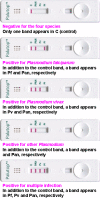Pfhrp2 and pfhrp3 polymorphisms in Plasmodium falciparum isolates from Dakar, Senegal: impact on rapid malaria diagnostic tests
- PMID: 23347727
- PMCID: PMC3571878
- DOI: 10.1186/1475-2875-12-34
Pfhrp2 and pfhrp3 polymorphisms in Plasmodium falciparum isolates from Dakar, Senegal: impact on rapid malaria diagnostic tests
Abstract
Background: An accurate diagnosis is essential for the rapid and appropriate treatment of malaria. The accuracy of the histidine-rich protein 2 (PfHRP2)-based rapid diagnostic test (RDT) Palutop+4® was assessed here. One possible factor contributing to the failure to detect malaria by this test is the diversity of the parasite PfHRP2 antigens.
Methods: PfHRP2 detection with the Palutop+4® RDT was carried out. The pfhrp2 and pfhrp3 genes were amplified and sequenced from 136 isolates of Plasmodium falciparum that were collected in Dakar, Senegal from 2009 to 2011. The DNA sequences were determined and statistical analyses of the variation observed between these two genes were conducted. The potential impact of PfHRP2 and PfHRP3 sequence variation on malaria diagnosis was examined.
Results: Seven P. falciparum isolates (5.9% of the total isolates, regardless of the parasitaemia; 10.7% of the isolates with parasitaemia ≤0.005% or ≤250 parasites/μl) were undetected by the PfHRP2 Palutop+4® RDT. Low parasite density is not sufficient to explain the PfHRP2 detection failure. Three of these seven samples showed pfhrp2 deletion (2.4%). The pfhrp3 gene was deleted in 12.8%. Of the 122 PfHRP2 sequences, 120 unique sequences were identified. Of the 109 PfHRP3 sequences, 64 unique sequences were identified. Using the Baker's regression model, at least 7.4% of the P. falciparum isolates in Dakar were likely to be undetected by PfHRP2 at a parasite density of ≤250 parasites/μl (slightly lower than the evaluated prevalence of 10.7%). This predictive prevalence increased significantly between 2009 and 2011 (P = 0.0046).
Conclusion: In the present work, 10.7% of the isolates with a parasitaemia ≤0.005% (≤250 parasites/μl) were undetected by the PfHRP2 Palutop+4® RDT (7.4% by the predictive Baker'model). In addition, all of the parasites with pfhrp2 deletion (2.4% of the total samples) and 2.1% of the parasites with parasitaemia >0.005% and presence of pfhrp2 were not detected by PfHRP2 RDT. PfHRP2 is highly polymorphic in Senegal. Efforts should be made to more accurately determine the prevalence of non-sensitive parasites to pfHRP2.
Figures

References
-
- Lee N, Baker J, Bell D, McCarthy J, Cheng Q. Assessing the genetic diversity of the aldolase genes of Plasmodium falciparum and Plasmodium vivax and its potential effect on performance of aldolase-detecting rapid diagnostic tests. J Clin Microbiol. 2006;44:4547–4549. doi: 10.1128/JCM.01611-06. - DOI - PMC - PubMed
-
- Baker J, Ho MF, Pelecanos A, Gatton M, Chen N, Abdullah S, Albertini A, Ariey F, Barnwell J, Bell D, Cunningham J, Djalle J, Echeverry DF, Gamboa D, Hii J, Kyaw MP, Luchavez J, Membi C, Menard D, Murillo C, Nhem S, Ogutu B, Onyor P, Oyibo W, Wang SQ, McCarthy J, Cheng Q. Global sequence variation in the histidine-rich proteins 2 and 3 of Plasmodium falciparum: implications for the performance of malaria rapid diagnostic tests. Malar J. 2010;9:129. doi: 10.1186/1475-2875-9-129. - DOI - PMC - PubMed
-
- Baker J, McCarthy J, Gatton M, Kyle DE, Belizario V, Luchavez J, Bell D, Cheng Q. Genetic diversity of Plasmodium falciparum histidine-rich protein 2 (PfHRP2) and its effect on the performance of PfHRP2-based rapid diagnostic tests. J Infect Dis. 2005;192:870–877. doi: 10.1086/432010. - DOI - PubMed
Publication types
MeSH terms
Substances
LinkOut - more resources
Full Text Sources
Other Literature Sources

